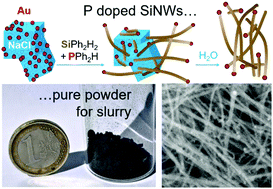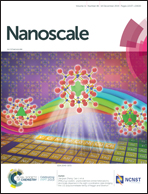Scalable chemical synthesis of doped silicon nanowires for energy applications†
Abstract
A versatile, low-cost and easily scalable synthesis method is presented for producing silicon nanowires (SiNWs) as a pure powder. It applies air-stable diphenylsilane as a Si source and gold nanoparticles as a catalyst and takes place in a sealed reactor at 420 °C (pressure <10 bar). Micron-sized NaCl particles, acting as a sacrificial support for the catalyst particles during NW growth, can simply be removed with water during purification. This process gives access to SiNWs of precisely controlled diameters in the range of 10 ± 3 nm with a high production yield per reactor volume (1 mg cm−3). The reaction was scaled up to 500 mg of SiNWs without altering the morphology or diameter. Adding diphenylphosphine results in SiNW n-type doping as confirmed by ESR spectroscopy and EDX analyses. The measured SiNW doping level closely follows the initial dopant concentration. Doping induces both an increase in diameter and a sharp increase of electrical conductivity for P concentrations >0.4%. When used in symmetric supercapacitor devices, 1% P-doped SiNWs exhibit an areal capacity of 0.25 mF cm−2 and retention of 80% of the initial capacitance after one million cycles, demonstrating excellent cycling stability of the SiNW electrodes in the presence of organic electrolytes.



 Please wait while we load your content...
Please wait while we load your content...